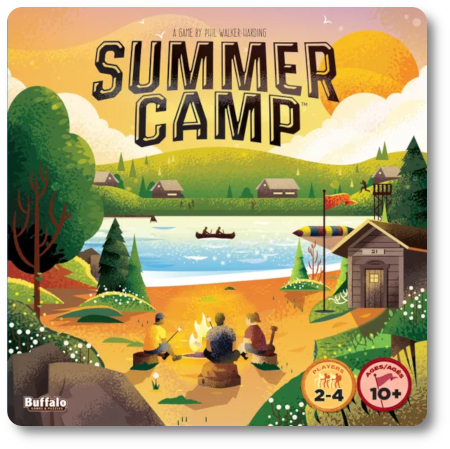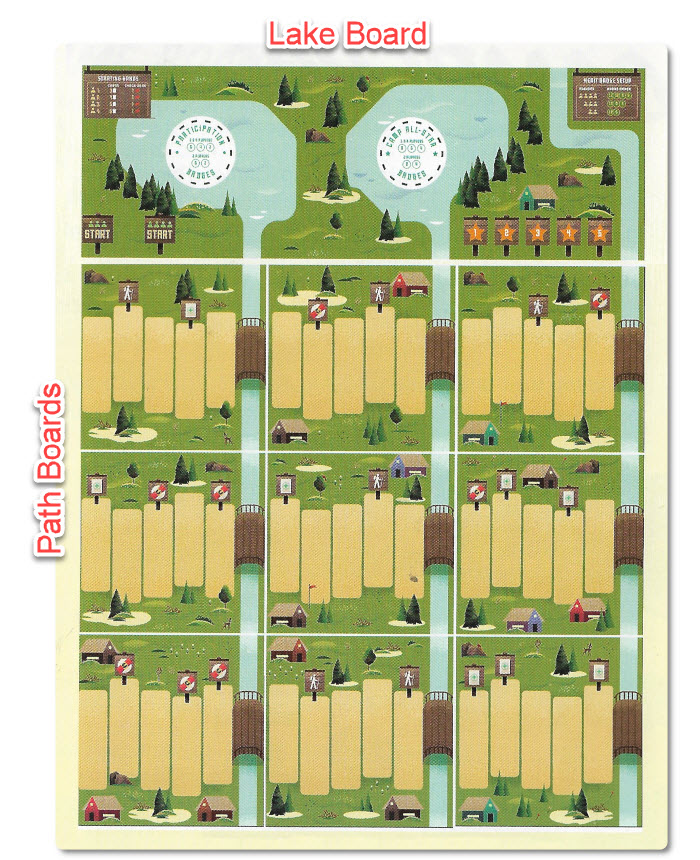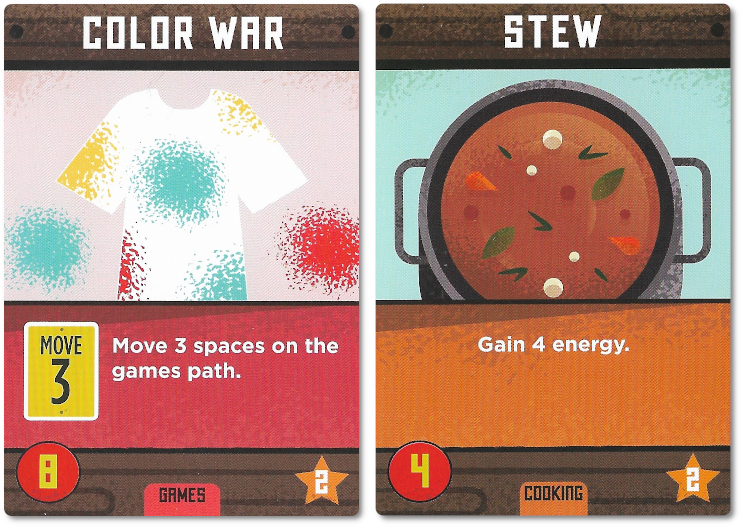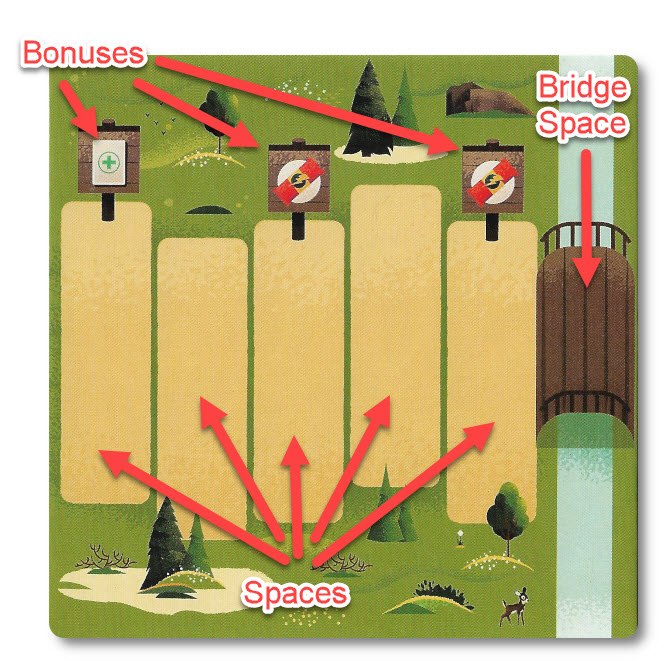 The Basics:
The Basics:
- For ages 10 and up
- For 2 to 4 players
- Approximately 45 minutes to complete
Geek Skills:
- Counting & Math
- Logical & Critical Decision Making
- Reading
- Strategy & Tactics
- Hand/Resource Management
Learning Curve:
- Child – Easy
- Adult- Easy
Theme & Narrative:
- Time for summer camp, S’mores, and memories!
Endorsements:
- Gamer Geek mixed!
- Parent Geek approved!
- Child Geek approved!
Overview
Summer camp, for many children, is the first opportunity to be away from their parents, jump in a stupidly cold lake, and master the sacred art of burning the bejesus out of your s’more. For some, it meant a night in cabins telling ghost stories by flashlight. For others, it meant sleeping under the stars and late-night campfires. For all, summer camp is an adventure full of memories, bug bites, and maybe a first kiss. Return to summer camp at your family table. This game does not require bug spray or sunscreen but will need you to think about how you want to build your adventure.
Summer Camp, designed by Phil Walker-Harding and published by Buffalo Games, is comprised of seven Activity packs (which includes 28 Activity cards per pack and four Merit Badge tokens per pack), one Base pack (which includes 64 Base cards and six Merit Badge tokens), one Lake board, nine Path boards, 24 Snack Bar tokens, one Starting Camper patch, four Player boards, and 12 pawns (four sets of three each). The tokens are made of thick cardboard and sturdy, as are the boards. The cards feel a bit on the flimsy side but should stand up to game playing. Pawns are made of solid wood. The illustrations by Adam Grason are colorful and clean.
Packing for Camp
To set up the game, first place the Lake board in the middle of the playing area and then place the nine Path boards under it using a 3×3 configuration. This will create three paths under the Lake board that go from left to right.

Second, take the three “Participation” and three “Camp All-Star” Merit Badge tokens from the Base pack. Place them on the indicates spaces found on the Lake board, staking them in ascending number values. Only a certain number will be used and is determined by the number of players in the game. Any unused Merit Badge tokens are returned to the Base pack box.
Third, as a group or randomly determine three Acitivy packs to play with. These include “Adventure”, “Arts & Crafts”, “Cooking”, “Friendship”, “Outdoors”, “Water Sports”, and “Games”. What you select matters, but not to a large degree. Each of the Activity packs includes similar actions and has unique actions specific to only that Activity pack. It’s recommended that “Cooking,” “Outdoors,” and “Water Sports” be selected if playing with new and inexperienced players.
Fourth, take the Merit Badge tokens and cards from the selected Activity packs. Place the Merit Badges to the right of the game boards at the end of the path, stacking them in ascending order (with the highest number value at the top and again based on the number of players).
Fifth, find and set aside all the “Move One Space” Activity cards from each of the selected Activity packs. Shuffle the remaining cards and place them face-down in their own separated draw deck and next to their corresponding activity (per the location of where you placed the Merit Badges). Draw two cards from each and place them face-up next to their draw deck.
Sixth, find and set aside all the “Lights Out” Base cards. Then, separate the “S’mores,” “Scavenger Hunt,” and “Free Time” Base cards and place them in their own separate face-up piles to one side of the game boards.
Seventh, have each player select a set of three pawns of the color of their choice and a matching colored Player board. Pawns are now placed in their starting position on the Path boards based on the number of players. Finally, have each player take one “Snack Bar” token and place the rest in a pile off to one side of the game boards.
Eighth, give each player seven “Lights Out” and one “Move One Space” card from each of the Activity packs. Have each player shuffle these cards together and place them face-down on the space indicated on their Player board. This is the player’s personal draw deck. Any remaining starting cards are returned to their game boxes.
Ninth, determine who will be the first player. Have this player draw three cards from their draw deck to form their starting hand. In turn order sequence, the next player draws four, and so on, until all players have drawn cards to create their hand, drawing one more card than the opponent previous to them. The number of cards drawn at the start of the game is only during game setup. During the game, all players will have a hand of five cards.
That’s it for game set up. Let’s have some fun at camp!
Camping Adventures!
Summer Camp is a deck-building game. Each player will have their own deck of cards that they will build by collecting cards of their choice. Everyone plays by the same rules, but the cards each player have will be very different. The game is played in rounds and turns with no set number of rounds per game. A player’s turn is summarized here.
Step One: Play Cards
The active player may play as many cards as they like from their current hand. Cards will, in general, provide the player two options. They can be played for the action described on the card or used to gain “energy,” which is used to buy additional cards. When a card is played, it’s placed face-up above the player’s board so all can view it.

If the card allows the player to move a pawn, the player moves their pawn on the path from left to right, as indicated by the number of spaces on the card played. Thematically speaking, this is meant to represent the player’s completeness and understanding of the Merit Badges they are working on. Any number of pawns may occupy the same space on the Path boards. If a pawn moves onto or through a space with a bonus action, the player immediately resolves the bonus. Bonuses include drawing cards, taking Snack Bar tokens, or additional movement on the Path board.

If the card is played for energy, the player may buy any face-up card from the draw piles by the game boards. The cost of the card is indicated by a number value found at the bottom of the cards. A player may buy as many cards as they like as long as they have the energy to pay for it and can do so at any time during their turn. This also includes buying multiple different times. All purchased cards are placed face-up in the player’s discard pile.
Snack Bar tokens can be exchanged for one energy each.
Any unspent energy derived from cards is lost at the end of the player’s turn. Snack Bar tokens, however, remain in the player’s possession until spent, for a maximum of six Snack Bar tokens by the time their turn ends.
Step Two: Discard
Any played cards are now placed in the player’s discard pile. Any cards still in the player’s hand are also placed in the discard pile.
Step Three: Draw Cards
The player now draws five cards from their draw deck. If the player’s draw deck is ever depleted, shuffle the player’s discard pile to create their new draw deck.
Step Four: Refill Display
If there are any vacant spaces beside the Activity draw decks, draw new cards to ensure that each Activity draw deck has two face-up cards each (for as long as there are cards to be drawn).
Step Five: Check for Badges
Check now to determine if the player has earned a Merit Badge. Merit Badges are earned in three different ways. When collecting Merit Badges, the player always takes the Merit Badge token at the top of the stack, which also happens to be the highest-numbered value token currently available.

- “Participation” Merit Badges are earned once the player has three of their pawns on or directly to the immediate right of the first bridge space on the Path boards.
- “All-Star” Merit Badges are earned once the player has three of their pawns on or directly to the immediate right of the second bridge space on the Path boards.
- “Activity” Merit Badges are earned once the player has any of their pawns reach the final bridge space on the path.
This concludes the player’s turn. Then, the next player takes their turn, starting with step one noted above. A game round is completed once all the players have had a turn.
The Last Day at Summer Camp
The end-game is triggered as soon as any player has collected all three “Activity” Merit badges, which can only be earned by moving their pawn to the final bridge space. Each player now finishes the round, taking their final turn.
All players then count the points earned.
- Count the number of points earned by Merit Badges
- Count the number of points earned by cards in the player’s deck (the point value indicated in a star found at the bottom of the card)
- Count the number of points earned by each pawn based on its current location when the game concluded
The player with the most points wins the game. Ties are broken by counting Snack Bar tokens with the player with the most winning the game.
To learn more about Summer Camp, visit the game’s webpage.
Final Word
 The Child Geeks had no problem learning and playing the game, finding it easy to understand how the cards worked and entertaining to build their “perfect summer camp adventure.” According to one Child Geek, “The game is easy to understand, and I like how all the cards can be used. There don’t appear to be any bad cards, but you should always try to get cards that move your guys.” Another Child Geek said, “I liked the game. It didn’t remind me of summer camp, but it did remind me of other games where you collect cards.” All the Child Geeks quickly grasped the need to balance buying power with movement with various degrees of success. It was unanimously agreed that movement should be the player’s top priority, especially when buying cards. They also all agreed that Summer Camp was a lot of fun to play.
The Child Geeks had no problem learning and playing the game, finding it easy to understand how the cards worked and entertaining to build their “perfect summer camp adventure.” According to one Child Geek, “The game is easy to understand, and I like how all the cards can be used. There don’t appear to be any bad cards, but you should always try to get cards that move your guys.” Another Child Geek said, “I liked the game. It didn’t remind me of summer camp, but it did remind me of other games where you collect cards.” All the Child Geeks quickly grasped the need to balance buying power with movement with various degrees of success. It was unanimously agreed that movement should be the player’s top priority, especially when buying cards. They also all agreed that Summer Camp was a lot of fun to play.
 The Parent Geeks found Summer Camp to be light and casual with a fun theme and visually interesting, with the pawns racing across the board. According to one Parent Geek, “Reminded me of the early day of Dominion and other deck-building games before they got overly convoluted and expensive with all the expansions. This game already comes with a lot of cards to play with. I don’t know how different each pack is, but I don’t think you need much in the variety to enjoy this game.” Another Parent Geek said, “A fun and easy game to enjoy. It was light enough to learn quickly and engaging enough to keep everyone at our table involved. Best of all, no mosquitoes or sunburns! A great way to enjoy camp and a game at the family table.” When all the camping gear was cleaned and put away, the Parent Geeks voted and fully approved Summer Camp for themselves, friends, and family.
The Parent Geeks found Summer Camp to be light and casual with a fun theme and visually interesting, with the pawns racing across the board. According to one Parent Geek, “Reminded me of the early day of Dominion and other deck-building games before they got overly convoluted and expensive with all the expansions. This game already comes with a lot of cards to play with. I don’t know how different each pack is, but I don’t think you need much in the variety to enjoy this game.” Another Parent Geek said, “A fun and easy game to enjoy. It was light enough to learn quickly and engaging enough to keep everyone at our table involved. Best of all, no mosquitoes or sunburns! A great way to enjoy camp and a game at the family table.” When all the camping gear was cleaned and put away, the Parent Geeks voted and fully approved Summer Camp for themselves, friends, and family.
 The Gamer Geeks appreciated Summer Camp for its rules, looks, and mechanics. However, they also believed it was too light and repetitive. According to one Gamer Geek, “I think this is a great example of a game you would play with anyone not familiar with deck-building games. It does an outstanding job of teaching the basics and challenges players enough to make each turn worth thinking through. However, if you are familiar with deck-building games, this one doesn’t give you anything new to consider or enjoy. So, great for an entry game into the hobby, but not for those of us who have been playing deck-building games for years.” Another Gamer Geek said, “I cannot say much in the way that is overly good or overly bad about this game. It feels very milquetoast to me. Nothing really there to challenge you and not a lot of depth. However, it does play well and is pretty fast. I liken it to the kiddy side of the pool. Yes, you can get wet and splash around, but you won’t be able to enjoy the diving board or water slide – ever – if you play this game. I recommend it for new players who will enjoy it and then quickly outgrow it.” When the last camper finally left the gaming table, the Gamer Geeks took a vote and gave Summer Camp a mixed endorsement. While they found nothing about the game poorly conceived, it was generally believed that the game was not deep enough to tempt a true gaming elitist.
The Gamer Geeks appreciated Summer Camp for its rules, looks, and mechanics. However, they also believed it was too light and repetitive. According to one Gamer Geek, “I think this is a great example of a game you would play with anyone not familiar with deck-building games. It does an outstanding job of teaching the basics and challenges players enough to make each turn worth thinking through. However, if you are familiar with deck-building games, this one doesn’t give you anything new to consider or enjoy. So, great for an entry game into the hobby, but not for those of us who have been playing deck-building games for years.” Another Gamer Geek said, “I cannot say much in the way that is overly good or overly bad about this game. It feels very milquetoast to me. Nothing really there to challenge you and not a lot of depth. However, it does play well and is pretty fast. I liken it to the kiddy side of the pool. Yes, you can get wet and splash around, but you won’t be able to enjoy the diving board or water slide – ever – if you play this game. I recommend it for new players who will enjoy it and then quickly outgrow it.” When the last camper finally left the gaming table, the Gamer Geeks took a vote and gave Summer Camp a mixed endorsement. While they found nothing about the game poorly conceived, it was generally believed that the game was not deep enough to tempt a true gaming elitist.
 Summer Camp is a really nice little game. It has everything a player needs to learn how to play deck-building games and a bit more. Collecting badges and moving pawns help drive home the importance of building the deck and provides a visual means to report their overall success. For example, if the player’s pawn is far behind, that’s a sure sign that the player’s deck needs to be adjusted to account for more movement. Other deck-building games don’t have this visual element, which most likely makes them more complex. Not the case here. A player – literally – always knows where they stand regarding their place in the winners’ circle.
Summer Camp is a really nice little game. It has everything a player needs to learn how to play deck-building games and a bit more. Collecting badges and moving pawns help drive home the importance of building the deck and provides a visual means to report their overall success. For example, if the player’s pawn is far behind, that’s a sure sign that the player’s deck needs to be adjusted to account for more movement. Other deck-building games don’t have this visual element, which most likely makes them more complex. Not the case here. A player – literally – always knows where they stand regarding their place in the winners’ circle.
Thematically, the game works very well. Some of our players had never been to a summer camp before, but this didn’t hold them back from understanding the game or its overly subtle narrative of adventure and growth. For those players who had gone to summer camp, they found the game to be a bit nostalgic, and our games were filled with stories about dips in the lake, camping adventures, and sneaking out to see the girls in their cabin or raiding the neighboring scouts’ campsite. A few bear and raccoon stories were also shared, much to the delight of the Child Geeks hearing their Parent Geeks reminisce about a time when they were kids, too. It brought families and friends together nicely and played smoothly.
I wouldn’t recommend Summer Camp to any gamer who already has a lot of experience with deck-building games or if they have their favorite already in their collection. I don’t believe Summer Camp brings anything new to the gaming table other than a nice visual way of communicating their overall progress and place in the end-game. Of course, if you have not had the pleasure of learning or playing a deck-building game, then it’s time to jump in! Summer Camp will be a great gateway into this game type and will certainly keep you entertained and engaged for many games to come. Do check it out.
This game was given to Father Geek as a review copy. Father Geek was not paid, bribed, wined, dined, or threatened in vain hopes of influencing this review. Such is the statuesque and legendary integrity of Father Geek.



